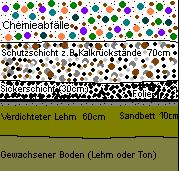Hazardous waste landfill
A hazardous waste dump is a storage facility for waste for which the safety precautions in normal waste dumps are insufficient. These landfills are environmentally neutral dumping grounds for hazardous waste . In Germany in a landfill is Recycling Law as a disposal facility for depositing waste defined ; "Hazardous waste dump" is not defined because the term hazardous waste is alien to German and European waste law. §2 Landfill Ordinance distinguishes between different landfill classes .
layout
When creating a hazardous waste dump, a water-impermeable layer is first introduced. Usually this is a layer of clay about one meter thick covered with thick plastic film.
This is followed by a water-permeable layer (sand or lean concrete ) in which seepage water drainage pipes are laid. This is followed by a layer of absorbent lime residue (approx. 70 cm). The waste is then deposited on top. The underground seal is raised towards the edge, so that the bottom of the landfill is designed as a trough. Leachate and rainwater released from the waste mountain collects in the drainage pipes and is drawn off via suction lines. It is collected in tanks and disposed of in wastewater treatment plants .
In order to prevent the waste materials from being washed out by penetrating rainwater, the top of the waste is first covered with rubble , then with a waterproof layer of clay and finally with topsoil after each landfill section is filled . Groundwater wells have been created around the landfill, from which samples are taken by the water authorities at regular intervals. In this way, groundwater pollution can be detected at an early stage.
The deposited waste is subject to the natural processes of aging and weathering in the landfill body. The chemical and biochemical processes that take place can heat the landfill body up to 80 ° C.
Problems
The main problem with landfills is sealing against the groundwater . Hazardous waste landfills are therefore only created in suitable places where the subsurface consists of clay or loam, so that there is a natural seal against the groundwater.
Highly toxic waste cannot be deposited in above-ground landfills. You will e.g. Some of them are packed in barrels and stored in controlled underground landfills. Underground landfills can only be created in rock salt deposits, since all other geological formations can be penetrated by groundwater. Numerous disused salt mine tunnels are currently used as storage facilities for hazardous waste. This underground dumping of hazardous waste ( disposal / final storage in landfill class IV in accordance with the Landfill Ordinance ) should not be confused with the mountain backfill of chemically and biologically inert and leachable waste ( recovery in accordance with the backfill ordinance ).
Example: Herfa-Neurode landfill
The world's largest underground hazardous waste dump is located in Herfa-Neurode, Hesse . The area of the underground landfill created by the potash mining extends over 400 square kilometers, with 250 km of so-called "main routes", including signposts, crossings, break rooms, workshops and our own fire department . Around 70,000 tonnes of potash are in potash plant Werra per day by blowing up won, making huge voids that are used in the disused parts of the mine for the toxic waste storage. Since opening in 1972, more than two million tons of toxic waste have accumulated, including 690,000 tons of dioxin and furan waste, 220,000 tons of mercury waste, 127,000 tons of cyanide waste and 83,000 tons of arsenic toxic waste.
history
Originally, hazardous waste was not disposed of separately, but treated like household waste. Disposal took place in household waste dumps, often without safety precautions. In the 1960s, for example, the chemical industry in the Basel area disposed of its solid waste in an exploited clay pit between Bonfol and Pfetterhausen in Alsace .
In Germany, the Schönberg / Ihlenberg landfill should be mentioned in particular for its aboveground ( surface ) storage, which made the GDR the largest importer of hazardous waste in Europe. This landfill is still active today under a new name. Another landfill that hit the headlines is the Münchehagen hazardous waste landfill in Lower Saxony . In 1985, a greatly increased concentration of the environmental toxin dioxin , which had become known due to the Seveso accident, was found at the landfill .
See also
- Hazardous waste
- Krasny Bor (hazardous waste landfill)
- Hazardous waste landfill Kölliken (Switzerland)
Web links
Individual evidence
- ↑ § 3 Paragraph 27 of the Recycling Management Act
- ↑ Displacement ordinance in the collection of regulations of the Baden-Württemberg Trade Inspectorate (PDF; 84 kB)
- ↑ Herfa-Neurode underground landfill . SZ Wissen 12/06, p. 64
- ↑ Die Welt: Herfa-Neurode underground landfill (from July 24, 2007)
- ↑ Martin Forter: Farbenspiel - A century of environmental use by the Basel chemical industry . Chronos Verlag Zurich, 2000. ISBN 3-905313-46-4
- ↑ 35 years of the Münchehagen toxic waste dump ( Memento from December 2, 2007 in the Internet Archive )
- ^ Tons of poison in the clay pit (Die Zeit, No. 50, December 6, 1985)
